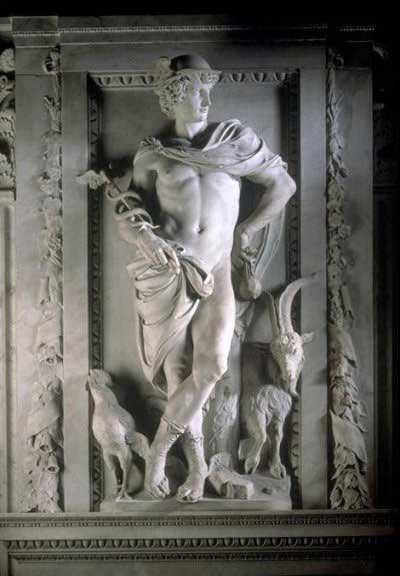
Today I’ve got another one of Aesop’s fables. I usually associate Aesop with animals but this one features the god Mercury and a sculptor.
Mercury, wanting to know how much he was esteemed among men, disguised himself as a traveler. He went into a sculptor’s workshop and saw figures of Jupiter, Juno, himself, and most of the other gods and goddesses. Pretending that he wanted to buy one, he said to the sculptor, pointing to the figure of Jupiter, “What do you ask for that?” “A drachma,” answered the man. “And what for that?” meaning Juno. The man named a higher price for that one.
Mercury’s eye now caught his own image. “Now, will this fellow,” thought he, “ask me ten times as much for this, for I am the messenger of heaven, and the source of all his gain?” Mercury asked the price, laying his hand on the figure of himself, with wings, rod, and all. “Why,” replied the man, “if you really mean business, and will buy the other two, I’ll throw you that fellow in to the bargain.
One version states the moral like this: “They, who are over-anxious to know how the world values them, will seldom be set down at their own price.”
It made me think of a couple people I know. People who I’m sure think the world’s opinion of them is much higher than it actually is. At least they’re not stupid enough to actually ask though.
Mercury says he is the source of the sculptor’s profits because in Roman mythology, he was the god of trade, profit and commerce. His name is related to the Latin word merx (“merchandise”; compare merchant, commerce, etc.).
Mercury has influenced the name of a number of things in a variety of scientific fields, such as the planet Mercury, the element mercury, and the plant mercury. The word mercurial is commonly used to refer to something erratic, volatile or unstable, derived from Mercury’s swift flights from place to place.
Mercury did not appear among the original gods of early Roman religion. Rather, he came around during the 3rd century BC, when the Roman and Greek religion kind of merged during the time of the Roman Republic, starting around the 3rd century BC. From the beginning, Mercury had essentially the same aspects as Hermes, wearing winged shoes and a winged petasos, and carrying the caduceus, a herald’s staff with two entwined snakes that was Apollo’s gift to Hermes.
Like Hermes, he was also a messenger of the gods and a god of trade, particularly of the grain trade. Mercury was also considered a god of abundance and commercial success. He also, like Hermes, led newly-deceased souls to the afterlife. Additionally, Ovid wrote that Mercury carried Morpheus’ dreams from the valley of Somnus to sleeping humans.
Thursday’s Tales is a weekly event here at Carol’s Notebook. Fairy tales, folktales, tall tales, even re-tellings, I love them all. Feel free to join in.
Stop by and visit Melissa at Mommy Wants to Read. today she’s featuring “The Pen and the Inkwell” by Hans Christian Anderson.

Oooh interesting. I love that the sculptor was going to throw in the one. You’re right about thinking of animals when it comes to Aesop’s Fables. I think I might have to do one of those for next weeks tale. This week I went with a Hans Christian Anderson one.
I liked this, but I do like the fables with animals the best.
I thought this one was interesting…
This was interesting